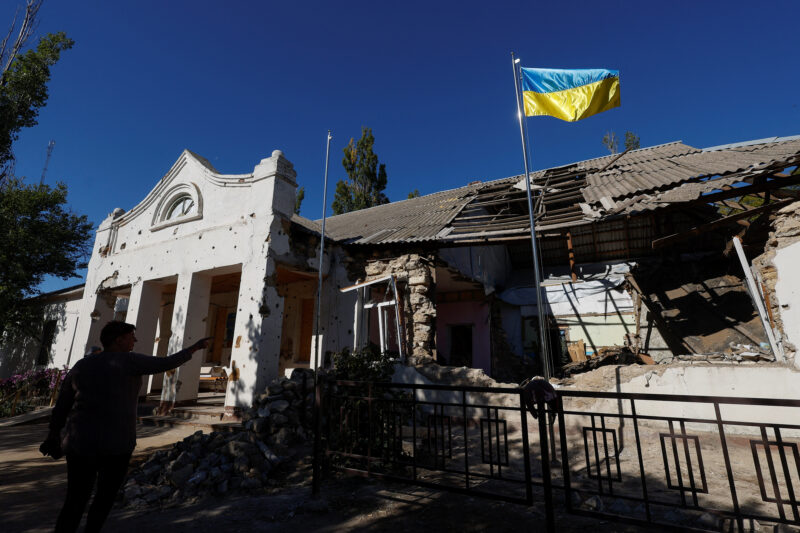KYIV/MIKOLAIV, Ukraine (Reuters) – President Vladimir Putin introduced martial law on Wednesday in four Ukrainian regions he says are part of Russia as some residents of the Russian-held city of Kherson left by boat after Moscow warned of a looming assault.
The images of people fleeing Kherson were broadcast by Russian state TV which portrayed the exodus – from the right bank of the Rover Dnipro to its left bank – as an attempt to clear the city of civilians before it became a combat zone.

Kirill Stremousov, deputy head of the local Russia-backed administration, made a video appeal after Russian forces in the area were driven back by 20-30 km (13-20 miles) in the last few weeks. They risk being pinned against the western bank of the 2,200-km (1367 miles) -long Dnipro river that bisects Ukraine.
In a move which looked designed to help Russia firm its grip on four Ukrainian regions it partly occupies and seeks to fully control – including the Kherson region – Putin told his Security Council he was introducing martial law in them.
Beyond much tighter security measures on the ground, it was unclear what the immediate impact of that would be.

Putin also issued a decree restricting movement in and out of eight regions adjoining Ukraine.
Andriy Yermak, the head of the Ukrainian president’s office, accused Russia of laying on a propaganda show in Kherson.
“The Russians are trying to scare the people of Kherson with fake newsletters about the shelling of the city by our army, and also arrange a propaganda show with evacuation,” Yermak wrote on the Telegram messaging app.
Eight months after being invaded, Ukraine is prosecuting major counter-offensives in the east and south to try to take as much territory as it can before winter after routing Russian forces in some areas.

Kherson is the biggest population centre Moscow has seized and held since it began its “special military operation” in Ukraine on Feb. 24. The city is on territory which President Vladimir Putin says is now formally incorporated into Russia, a move Ukraine and the West do not recognise.
The conflict has killed thousands, displaced millions, pulverised Ukrainian cities, shaken the global economy and revived Cold War-era geopolitical fissures.
Ukrainian cities have also been struck in recent days by drones and missiles, and Vitali Klitschko, Kyiv’s mayor, said the capital’s air defences were in action once again on Wednesday.
In Kherson, Stremousov said the city and especially its right bank could be shelled by Ukrainian forces, adding that residents who left would be given accommodation inside Russia.

“I ask you to take my words seriously and to interpret them as a call to evacuate as fast as you possibly can,” he said.
“We do not plan to surrender the city, we will stand until the last moment.”
OFFENSIVE EXPECTED
The Russian-installed chief of Kherson region, Stremousov’s boss, said about 50,000-60,000 people would be evacuated in the next six days. The city of Kherson had a pre-war population of around 280,000 people but many of them have since fled.
“The Ukrainian side is building up forces for a large-scale offensive,” said Vladimir Saldo, the official, told state TV. “Where the military operates, there is no place for civilians.”
Saldo, who said Russia had the resources to hold Kherson and even counter attack if necessary, also said he was banning civilians from entering the region for seven days.
Staff at Kherson’s Russian-backed administration were also being relocated to the left bank of the Dnipro, he said.
The evacuation calls followed a gloomy assessment of Russia’s prospects in the area from General Sergei Surovikin, the new commander of Russian forces in Ukraine.

“The situation in the area of the ‘Special Military Operation’ can be described as tense,” Surovikin told state-owned Rossiya 24 news channel. “The situation in this area (Kherson) is difficult. The enemy is deliberately striking infrastructure and residential buildings.”
Vladimir Rogov, a member of the Russian-installed council governing Zaporizhzhia, another region in the south, said Ukraine’s forces had intensified overnight shelling of Russian-held Enerhodar. Many employees of the Zaporizhzhia nuclear station live there.
Artillery fire had hit the town’s outskirts and there had been 10 strikes around a thermal power station, he said on the Telegram messaging app on Wednesday.
Dmytro Orlov, whom Ukraine recognises as mayor of Enerhodar, blamed Russia for the shelling.
“The shelling, first of the industrial zone, and then of the city itself, began around midnight and it did not stop in the morning,” he posted on Telegram.
International Atomic Energy Agency chief Rafael Grossi said he expected to return soon to Ukraine amid negotiations to establish a protection zone around the Zaporizhzhia facility, Europe’s largest nuclear power station.
The plant is in one of four Ukrainian regions Russia has proclaimed as annexed but only partly occupies. The other three are Kherson, and the eastern border provinces of Donetsk and Luhansk – together known as Donbas.
Putin declared them regions of Russia after staging what Moscow called referendums in September, which Kyiv and Western governments denounced as illegal and coercive.
(Reporting by Reuters bureaux; Writing by Himani Sarkar and Andrew Osborn; Editing by Andrew Cawthorne)

